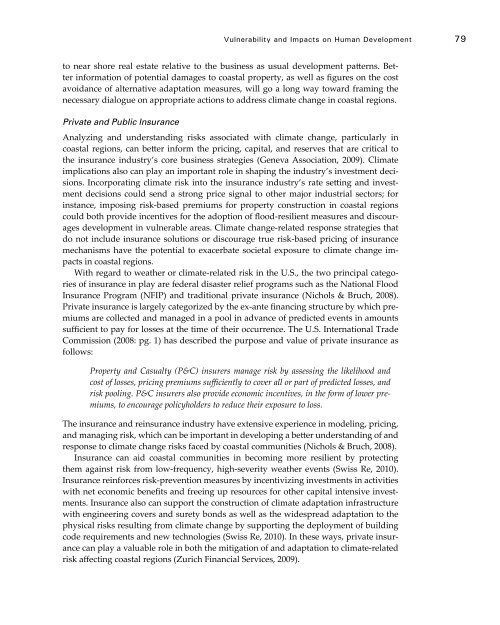Coastal Impacts, Adaptation, and Vulnerabilities - Climate ...
Coastal Impacts, Adaptation, and Vulnerabilities - Climate ...
Coastal Impacts, Adaptation, and Vulnerabilities - Climate ...
Create successful ePaper yourself
Turn your PDF publications into a flip-book with our unique Google optimized e-Paper software.
Vulnerability <strong>and</strong> <strong>Impacts</strong> on Human Development 79to near shore real estate relative to the business as usual development patterns. Betterinformation of potential damages to coastal property, as well as figures on the costavoidance of alternative adaptation measures, will go a long way toward framing thenecessary dialogue on appropriate actions to address climate change in coastal regions.Private <strong>and</strong> Public InsuranceAnalyzing <strong>and</strong> underst<strong>and</strong>ing risks associated with climate change, particularly incoastal regions, can better inform the pricing, capital, <strong>and</strong> reserves that are critical tothe insurance industry’s core business strategies (Geneva Association, 2009). <strong>Climate</strong>implications also can play an important role in shaping the industry’s investment decisions.Incorporating climate risk into the insurance industry’s rate setting <strong>and</strong> investmentdecisions could send a strong price signal to other major industrial sectors; forinstance, imposing risk-based premiums for property construction in coastal regionscould both provide incentives for the adoption of flood-resilient measures <strong>and</strong> discouragesdevelopment in vulnerable areas. <strong>Climate</strong> change-related response strategies thatdo not include insurance solutions or discourage true risk-based pricing of insurancemechanisms have the potential to exacerbate societal exposure to climate change impactsin coastal regions.With regard to weather or climate-related risk in the U.S., the two principal categoriesof insurance in play are federal disaster relief programs such as the National FloodInsurance Program (NFIP) <strong>and</strong> traditional private insurance (Nichols & Bruch, 2008).Private insurance is largely categorized by the ex-ante financing structure by which premiumsare collected <strong>and</strong> managed in a pool in advance of predicted events in amountssufficient to pay for losses at the time of their occurrence. The U.S. International TradeCommission (2008: pg. 1) has described the purpose <strong>and</strong> value of private insurance asfollows:Property <strong>and</strong> Casualty (P&C) insurers manage risk by assessing the likelihood <strong>and</strong>cost of losses, pricing premiums sufficiently to cover all or part of predicted losses, <strong>and</strong>risk pooling. P&C insurers also provide economic incentives, in the form of lower premiums,to encourage policyholders to reduce their exposure to loss.The insurance <strong>and</strong> reinsurance industry have extensive experience in modeling, pricing,<strong>and</strong> managing risk, which can be important in developing a better underst<strong>and</strong>ing of <strong>and</strong>response to climate change risks faced by coastal communities (Nichols & Bruch, 2008).Insurance can aid coastal communities in becoming more resilient by protectingthem against risk from low-frequency, high-severity weather events (Swiss Re, 2010).Insurance reinforces risk-prevention measures by incentivizing investments in activitieswith net economic benefits <strong>and</strong> freeing up resources for other capital intensive investments.Insurance also can support the construction of climate adaptation infrastructurewith engineering covers <strong>and</strong> surety bonds as well as the widespread adaptation to thephysical risks resulting from climate change by supporting the deployment of buildingcode requirements <strong>and</strong> new technologies (Swiss Re, 2010). In these ways, private insurancecan play a valuable role in both the mitigation of <strong>and</strong> adaptation to climate-relatedrisk affecting coastal regions (Zurich Financial Services, 2009).
















